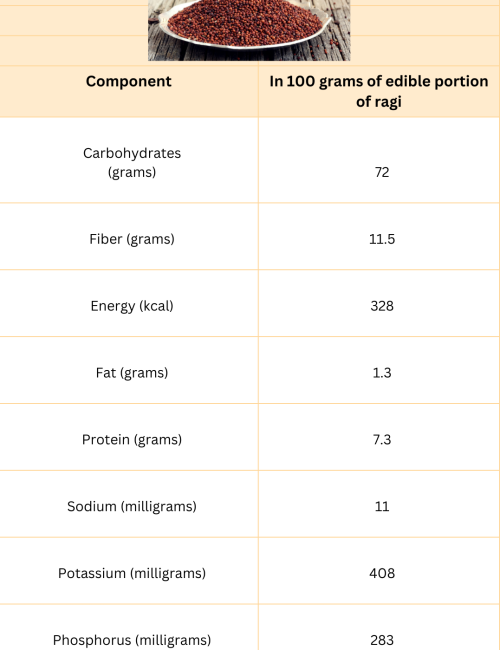Ragi (finger millet) use in kidney disease
Ragi (finger millet) is a type of millet commonly used in several regions of India. Ragi is traditionally processed by many methods like malting, fermentation, and grinding to produce beverages, porridge, idli, dosa, and roti in India. Ragi is nutritionally superior to polished white rice. Patients with chronic kidney disease (CKD) and those on dialysis have special diet requirements because their kidneys are not fully functional. The components of the diet, like protein, phosphorus, sodium, and potassium, when in excess, can cause harm to these patients

If we look at the nutritional composition of ragi, it is a rich source of carbohydrates (72%) and has a dietary fiber of 11.5%. The fiber content of ragi is much higher than brown rice and polished rice. If we take 100 grams of the edible portion of ragi, it contains 72 grams of carbohydrates, 11.5 grams of fiber, 328 kcal of energy, 1.3 grams of fat, 7.3 grams of protein, 11mg of sodium, 408mg of potassium, 283 mg of phosphorus and 3.9mg of iron.

In patients with CKD and those on dialysis, phosphorus accumulates in the blood because kidneys can’t excrete it in the urine properly. So, if our diet contains high phosphorus, it accumulates in the blood and can lead to bone and heart problems. To prevent excess levels of phosphorus in the blood, phosphorus restriction is advised in patients with CKD with high phosphorus levels and those on dialysis. Ragi had 283mg of phosphorus in 100 grams of a portion which is a high value. In patients with CKD with high phosphorus values, their daily phosphorus intake is restricted to 800mg, which is for the whole day, including all the foods. So ragi consumption should be restricted in patients with higher phosphorus levels and patients with advanced stages of CKD on dialysis after consulting the nephrologist and dietician.
High potassium levels are an important concern in patients with CKD and those on dialysis. Higher potassium levels beyond 5.5meq/L, there is decreased survival and increased risk of cardiac events. So, potassium levels should be maintained below 5meq/L, preferably in these patients (at least below 5.5meq/L). Potassium restriction of up to 3000mg per day is advised in patients with CKD. Ragi has 408mg of potassium per 100 grams, which makes it a high-potassium diet. A high-potassium diet is defined as something which contains more than 200mg of potassium per 100 grams. So, in patients on dialysis whose baseline potassium values are around 5 to 5.5 meq/L, it is better to restrict ragi intake to avoid hyperkalemia. Nephrologist and dietician advise in other patients with milder CKD is advised.
Dr.Kishore Kumar Ariga
Nephrologist and Kidney transplant physician
